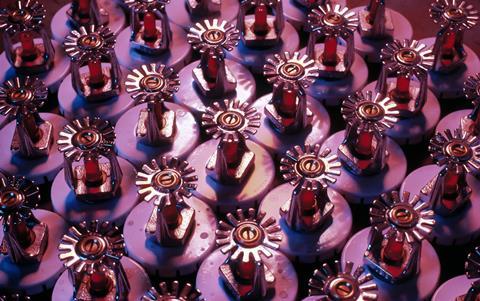Current height limit of 30m should be cut to at least 11m

The Local Government Association has called on the government to lower the height limit at which new and existing residential buildings were required to feature automatic fire-suppression systems, such as sprinklers, from 30m down to 18m.
And the RIBA, RICS and CIOB have gone further, arguing for an 11m limit.
At its annual conference in Brighton today the LGA, which represents 370 councils and all fire and rescue authorities in England, warned that tougher rules needed to be introduced to protect people living in high-rise buildings.
The LGA said that proposals in the Hackitt report following the Grenfell fire in 2017 – that owners of existing towers blocks in excess of 30m high would have to satisfy regulators such structures were safe – did not go far enough and called for this threshold to be reduced, “given the practicalities of fire-fighting”.
Cuts to fire and rescue budgets meant that safety checks on existing towers was at risk and the government had to step in to support the work, it added.
Ian Stephens, chair of the LGA’s fire services management committee, told the conference that residents had a right to feel safe in their home and sprinklers, while not a universal panacea, “offer strong reassurance that is urgently needed following the Grenfell Tower tragedy”.
Installation should be proportionate and risk-based, Stephens said, but given that local authorities faced an £8bn funding gap by 2025 and might struggle to meet the requirements he called on the government “to provide funding for this work as it has for the remediation of flammable cladding”.
“The cost benefit case for them in new high-rise tower blocks and care homes has been made and retrofitting needs to be considered in existing buildings as part of a holistic approach to fire safety,” he added.
Studies showed sprinklers worked on 94% of occasions and then extinguished or contained the fire in 99% of incidents and reduce fire injuries and fire damage by 80%, the LGA said.
The association also called for fire suppression systems to be installed in all new premises where what it termed “vulnerable people” slept, including care homes and residential schools.
Meanwhile the RIBA, the RICS and the Chartered Institute of Building have signed a joint statement calling on the government to require the installation of sprinklers in all new and converted residential buildings, hotels, hospitals, student accommodation, schools and care home buildings of 11m in height or above across the UK.
The three organisations have also called for the retrofitting of sprinklers in buildings “when relevant refurbishment takes place”.
The use of automatic fire suppression systems, including sprinklers, saved lives and property, the trio said, and while England, Wales, Scotland and Northern Ireland differed in their requirements on sprinklers “the science of fire knows no political or geographical boundaries” the three said in a statement ahead of a deabte in London on fire safety.
“Harmonising building regulations across the nation states of the UK regarding the installation of sprinklers would provide clarity to the industry and help protect the public,” the three organisations added.











No comments yet